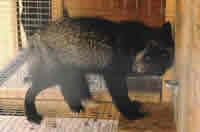|
|
What is Ecologically Friendly Fashion?
Ecologically friendly fashion is apparel that is manufactured, marketed, used and disposed of with little or no harm to people, animals and the environment. Most people are unaware that their purchase of fashion products, such as fur and leather, contributes to the suffering of animals through inhumane living conditions and killing methods. It also contributes to the degradation of our environment through destructive practises that pollute this planet and threatens the health of both humans and animals.
Does What You Wear Support Factory Farming?
If you are opposed to the deplorable and unhealthy conditions in which factory farmed animals are raised, and if you are aware of how factory farming contributes to human health hazards, then you certainly would not want to support this system by purchasing its profitable animal by-products. The meat industry would be unable to sustain itself were it not for the profits from leather sales. Only 432 pounds of a 1000 steer becomes retail beef. The remaining 568 pounds are classified as by-products. In the United States alone, the processing of animal by-products is a multi-billion dollar industry.
What are the Hidden By-products of Factory Farming?
Apart from its obvious uses for shoes, purses, belts, upholstery and the like, cattle hide is also used in insulation, as a base for ointments and as a binder for plaster and asphalt. Cattle hair is used in toothbrush bristles, mattresses, air filters and covers for furniture. Hides, along with connective tissue, cartilage, blood and bones, are used to make products such glue in plywood, paper, matches, textiles, cardboard and window shades.
What Fashion Products are Unfriendly?
The production of fur coats and other fur products causes agonizing suffering to animals which are either inhumanely trapped in the wild or raised in appalling conditions on fur farms.
 Foxes and other wildlife are kept under stressful, inhumane conditions on fur farms. They suffer both psychologically and physically from health problems such as painful stomach ulcers. Foxes and other wildlife are kept under stressful, inhumane conditions on fur farms. They suffer both psychologically and physically from health problems such as painful stomach ulcers.
When housed in small cages fox and mink develop extreme abnormal behavioural patterns.
Millions of commercially unusable “trash animals”, including birds, dogs, cats and endangered wildlife, are maimed and killed in leg hold traps every year. There are no laws that stop the cruelty to wildlife raised on fur farms.
It takes as many as 27 raccoons or 55 minks or 30 rabbits to make one fur coat. Brutal killing methods include electrocution, gassing, neck breaking and suffocation. Anything is tried as long as it doesn’t damage the fur.
In India, kid gloves are produced by boiling baby goats alive in herbal liquids. Persian lamb is made fro Karakul lambs who are skinned alive within 24 to 48 hours of birth in order to keep the curl in their coats.
The production of wool also causes immense suffering. Shearing is a terrifying ordeal and results in cuts and gashes. Australian surveys have revealed that millions of lambs and sheep die each year from exposure to harsh weather during the first 30 days following shearing.
Animal husbandry methods can be barbaric. For example, mulesing is a gruesome operation on sheep in which huge strips of flesh are cut off the backs of their legs. The pain will last for weeks and months. This is done to prevent “flystrike” if the sheeps’ wrinkly skin traps feces, urine and moisture, and in turn attracts flies and maggots. However, in an attempt to create a smooth scar, the large, bloody wounds get flystrike or become infected.
Proper and humane shepherding and husbandry can reduce some of the suffering but the massive deaths are an inherent part of factory farming.
Leather is a crucial and very profitable commercial by-product of the meat industry. Leather can be replaced in your wardrobe with faux leather footwear, belts, purses and wallets made from synthetics, plastic and cotton. Non-leather accessories are fashionable, readily available and cruelty free.
What Fashion is Ecologically Friendly?
There are numerous alternatives that exist so we no longer need to steal the skins of animals to keep warm or be fashionable. Cottons, velours, velveteens, polyesters, satin and nylon are attractive alternatives. These materials cause considerably less harm to to the environment as compared to animal products. Non-animal synthic fur coats are often mistaken for real fur, so it might be a good idea to wear an “Make No Mistake – It’s Fake” button.
How is the Environment Harmed by animal Fashions?
Wildlife populations are displaced by the large herds of domestic animals, and by hunting and trapping. The widespread extermination of wildlife to protect livestock creates imbalances in ecosystems.
Strong chemicals and dyes are used in the processing of pelts. Waste from the fur industry is a serious source of environmental pollution.
What Can I Do?
- Avoid purchasing any products derived from animals (wool, silk, leather, etc.)
- Wise shopping and purchasing ecologically friendly products will influence manufacturers and merchants to change
- Ask the manager if the store to stock non-animal products
- Recycle your clothing
|
|